TimTaiLieu.vn - Tài liệu, ebook, giáo trình, đồ án, luận văn
Tổng hợp tất cả tài liệu, ebook, giáo trình Tài Chính Tiền Tệ chọn lọc và hay nhất.

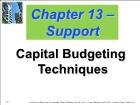 Bài giảng Financial Management - Chapter 13 – Support: Capital Budgeting Techniques
Bài giảng Financial Management - Chapter 13 – Support: Capital Budgeting TechniquesRemember? The Different Methods of Evaluation? Payback Period (PBP) Internal Rate of Return (IRR) Net Present Value (NPV) Profitability Index (PI) Let us use the ‘New Asset’ project from Chapter 12 (VW13E-13b.xlsx)
 28 trang | Chia sẻ: nguyenlinh90 | Ngày: 20/07/2019 | Lượt xem: 768 | Lượt tải: 0
28 trang | Chia sẻ: nguyenlinh90 | Ngày: 20/07/2019 | Lượt xem: 768 | Lượt tải: 0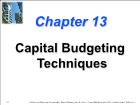 Bài giảng Financial Management - Chapter 13: Capital Budgeting Techniques
Bài giảng Financial Management - Chapter 13: Capital Budgeting TechniquesAfter Studying Chapter 13, you should be able to: Understand the payback period (PBP) method of project evaluation and selection, including its: (a) calculation; (b) acceptance criterion; (c) advantages and disadvantages; and (d) focus on liquidity rather than profitability. Understand the three major discounted cash flow (DCF) methods of project...
 65 trang | Chia sẻ: nguyenlinh90 | Ngày: 20/07/2019 | Lượt xem: 699 | Lượt tải: 0
65 trang | Chia sẻ: nguyenlinh90 | Ngày: 20/07/2019 | Lượt xem: 699 | Lượt tải: 0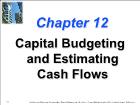 Bài giảng Financial Management - Chapter 12: Capital Budgeting and Estimating Cash Flows
Bài giảng Financial Management - Chapter 12: Capital Budgeting and Estimating Cash FlowsAfter Studying Chapter 12, you should be able to: Define capital budgeting and identify the steps involved in the capital budgeting process. Explain the procedure to generate long-term project proposals within the firm. Justify why cash, not income, flows are the most relevant to capital budgeting decisions. Summarize in a “checklist” the ma...
 34 trang | Chia sẻ: nguyenlinh90 | Ngày: 20/07/2019 | Lượt xem: 762 | Lượt tải: 0
34 trang | Chia sẻ: nguyenlinh90 | Ngày: 20/07/2019 | Lượt xem: 762 | Lượt tải: 0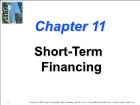 Bài giảng Financial Management - Chapter 11: Short-Term Financing
Bài giảng Financial Management - Chapter 11: Short-Term FinancingAfter Studying Chapter 11, you should be able to: Understand the sources and types of spontaneous financing. Calculate the annual cost of trade credit when trade discounts are forgone. Explain what is meant by "stretching payables" and understand its potential drawbacks. Describe various types of negotiated (or external) short-term borrowing...
 42 trang | Chia sẻ: nguyenlinh90 | Ngày: 20/07/2019 | Lượt xem: 848 | Lượt tải: 0
42 trang | Chia sẻ: nguyenlinh90 | Ngày: 20/07/2019 | Lượt xem: 848 | Lượt tải: 0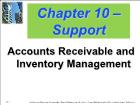 Bài giảng Financial Management - Chapter 10 – Support: Accounts Receivable and Inventory Management
Bài giảng Financial Management - Chapter 10 – Support: Accounts Receivable and Inventory ManagementExample of Relaxing Credit Standards The firm is currently producing a single product with variable costs of $20 and selling price of $25. Relaxing credit standards is not expected to affect current customer payment habits. Additional annual credit sales of $120,000 and an average collection period for new accounts of 3 months is expected. The ...
 11 trang | Chia sẻ: nguyenlinh90 | Ngày: 20/07/2019 | Lượt xem: 728 | Lượt tải: 0
11 trang | Chia sẻ: nguyenlinh90 | Ngày: 20/07/2019 | Lượt xem: 728 | Lượt tải: 0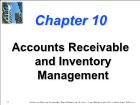 Bài giảng Financial Management - Chapter 10: Accounts Receivable and Inventory Management
Bài giảng Financial Management - Chapter 10: Accounts Receivable and Inventory ManagementAfter Studying Chapter 10, you should be able to: List the key factors that can be varied in a firm's credit policy and understand the trade-off between profitability and costs involved. Understand how the level of investment in accounts receivable is affected by the firm's credit policies. Critically evaluate proposed changes in credit policy...
 54 trang | Chia sẻ: nguyenlinh90 | Ngày: 20/07/2019 | Lượt xem: 955 | Lượt tải: 0
54 trang | Chia sẻ: nguyenlinh90 | Ngày: 20/07/2019 | Lượt xem: 955 | Lượt tải: 0 Bài giảng Financial Management - Chapter 9: Cash and Marketable Securities Management
Bài giảng Financial Management - Chapter 9: Cash and Marketable Securities ManagementAfter Studying Chapter 9, you should be able to: List and explain the motives for holding cash. Understand the purpose of efficient cash management. Describe methods for speeding up the collection of accounts receivable and methods for controlling cash disbursements. Differentiate between remote and controlled disbursement, and discuss any et...
 60 trang | Chia sẻ: nguyenlinh90 | Ngày: 20/07/2019 | Lượt xem: 944 | Lượt tải: 0
60 trang | Chia sẻ: nguyenlinh90 | Ngày: 20/07/2019 | Lượt xem: 944 | Lượt tải: 0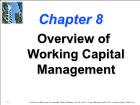 Bài giảng Financial Management - Chapter 8: Overview of Working Capital Management
Bài giảng Financial Management - Chapter 8: Overview of Working Capital ManagementAfter Studying Chapter 8, you should be able to: Explain how the definition of "working capital" differs between financial analysts and accountants. Understand the two fundamental decision issues in working capital management – and the trade-offs involved in making these decisions. Discuss how to determine the optimal level of current assets. ...
 26 trang | Chia sẻ: nguyenlinh90 | Ngày: 20/07/2019 | Lượt xem: 678 | Lượt tải: 0
26 trang | Chia sẻ: nguyenlinh90 | Ngày: 20/07/2019 | Lượt xem: 678 | Lượt tải: 0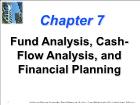 Bài giảng Financial Management - Chapter 7: Fund Analysis, Cash-Flow Analysis, and Financial Planning
Bài giảng Financial Management - Chapter 7: Fund Analysis, Cash-Flow Analysis, and Financial PlanningAfter Studying Chapter 7, you should be able to: Explain the difference between the flow of funds (sources and uses of funds) statement and the statement of cash flows – and understand the benefits of using each. Define "funds" and identify sources and uses of funds. Create a sources and uses of funds statement, make adjustments, and analyze t...
 59 trang | Chia sẻ: nguyenlinh90 | Ngày: 20/07/2019 | Lượt xem: 705 | Lượt tải: 0
59 trang | Chia sẻ: nguyenlinh90 | Ngày: 20/07/2019 | Lượt xem: 705 | Lượt tải: 0 Bài giảng Financial Management - Chapter 6 –Support: Financial Statement Analysis
Bài giảng Financial Management - Chapter 6 –Support: Financial Statement AnalysisRemember? Common-size Analysis An analysis of percentage financial statements where all balance sheet items are divided by total assets and all income statement items are divided by net sales or revenues.
 13 trang | Chia sẻ: nguyenlinh90 | Ngày: 20/07/2019 | Lượt xem: 754 | Lượt tải: 0
13 trang | Chia sẻ: nguyenlinh90 | Ngày: 20/07/2019 | Lượt xem: 754 | Lượt tải: 0
Website đang trong thời gian thử nghiệm, chờ xin giấy phép của Bộ TT & TT.

